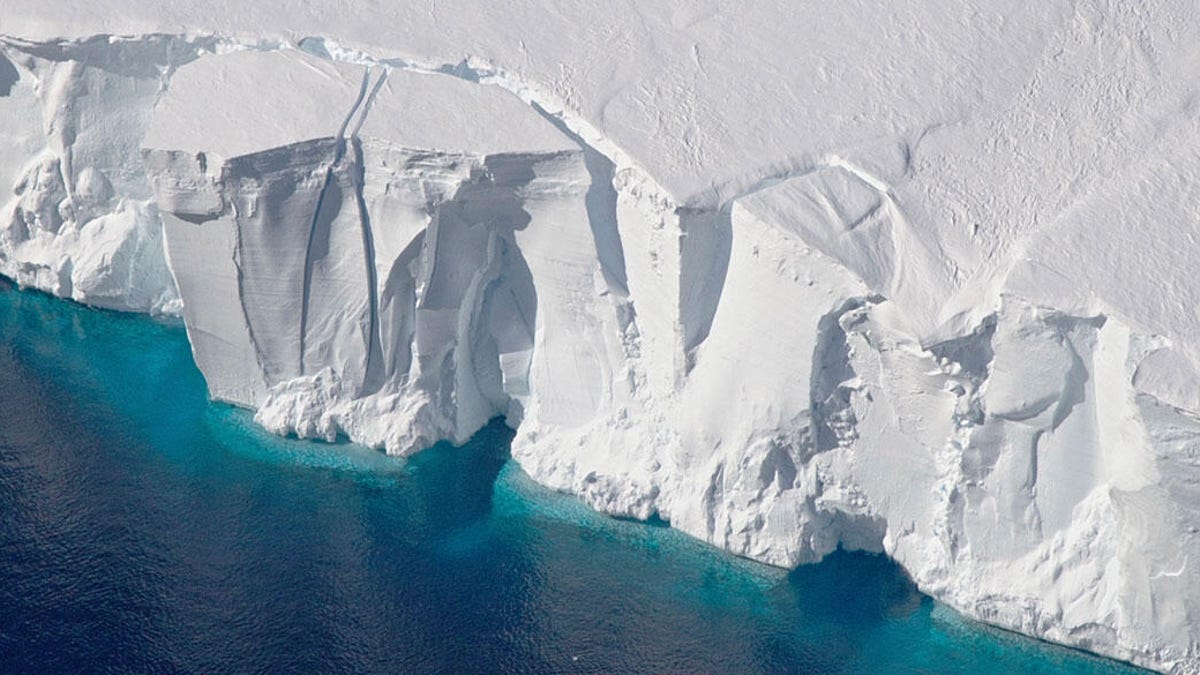NASA Study Reveals Decades of Antarctic Ice Loss That Went Under the Radar
"It's unlikely Antarctica can grow back to its pre-2000 extent by the end of this century," researchers say.

The 200-foot-tall (60-meter-tall) front of the Getz Ice Shelf in Antarctica is scored with cracks where icebergs are likely to break off, or calve, in this 2016 photo.
Since 1997, the edge of Antarctica's ice sheet has lost about 12 trillion metric tons of ice, according to a NASA-led study based on satellite imagery and published Wednesday in the journal Nature. That rather alarming fact is made worse by the researchers' realization that this figure is twice what previous estimates suggested and that ice loss is likely to accelerate in tandem with Earth's climate warming as a result of human-induced climate change.
"Antarctica is crumbling at its edges," Chad Greene, lead author of the study and scientist at NASA's Jet Propulsion Laboratory, said in a press release. "And when ice shelves dwindle and weaken, the continent's massive glaciers tend to speed up and increase the rate of global sea level rise."
In other words, the reason we need to worry about Antarctica's glacial shelf extends far beyond preservation of one of our planet's purest regions.
You can think of Antarctica's giant, frozen and intact ice sheets as storage facilities for fresh water. If the shelves at the edge of the sheet start to melt, the water they hold trickles into the ocean and, over time, sea levels rise. When ice breaks off the continent and into the ocean it's known as "calving."
Normally, calving happens naturally and at a pretty steady rate, meaning ice shelves have a constant size over the long term and sea levels have a generally consistent level, too. "But in recent decades," NASA said, "the warming ocean has been destabilizing Antarctica's ice shelves by melting them from below, making them thinner and weaker." Earlier this year, an ice shelf as big as Los Angeles disintegrated before our eyes.
It's not a coincidence that, also in recent decades, climate change has forced ocean temperatures to rise exponentially.
Changes in elevation of the Antarctic ice sheet from 1985 to 2021 are shown. Ice height diminishes (red) as the ice sheet melts by contact with ocean water; it rises (blue) where accumulation exceeds melting. Ice shelves are shown in gray. The missions that supplied data are listed at bottom.
Even though some variations in climate are to be expected, as evidenced by history, temperature rises aren't supposed to happen this quickly -- it's simply too fast and unsustainable for wildlife to survive, natural Earth cycles to remain in equilibrium and for us to protect our planet. No, this rapid rate is because human activities, such as burning fossil fuels for energy and cutting down forests, are forcing global temperatures to spike.
"Losses from calving have outpaced natural ice-shelf growth so greatly that the researchers think it's unlikely Antarctica can grow back to its pre-2000 extent by the end of this century," NASA said of the new study. Reality is quite the opposite, actually.
The study, which thoroughly analyzed the edges of ice shelves comprising about 30,000 linear miles (50,000 kilometers) of Antarctic coastline, suggests that the snowy continent's largest shelves are headed toward major calving events in the next 10 to 20 years, NASA said.
To make matters worse, an accompanying NASA-led study published in Earth System Science Data indicates ice thinning in Antarctica has also spread from the continent's outer edges to its interior, a process that nearly doubled in western parts of the ice sheet over the past decade. This conclusion stems from a combination of nearly 3 billion data points from seven space-borne instruments to "produce the longest continuous data set on the changing height of the ice sheet…from as early as 1985," according to the agency.
"Subtle changes like these, in combination with improved understanding of long-term trends from this data set, will help researchers understand the processes that influence ice loss, leading to improved future estimates of sea level rise," Johan Nilsson, lead author of the second study and scientists at NASA's Jet Propulsion Laboratory, said in the release.
National Geographic emphasizes the importance of monitoring sea level rise, as an example, because its consequences include increased intensity of storm surges, flooding and damage to coastal areas. What this means is large population centers in vulnerable places, in addition to wildlife, will have to relocate from their homes.
Citizens of Bangladesh, for instance, have been battling an increased amount of tragic cyclones powered by climate change that have occurred annually for the past several years. These storms claimed the lives of many coastal inhabitants, and survivors were shuttled into sheltered areas after witnessing the loss of their homes.
As Nilsson put it, the years of work and thousands of hours put into this type of research is worth it. "Condensing the data into something widely useful may bring us closer to the big breakthroughs we need to better understand our planet and to help prepares us for the future impacts of climate change."

